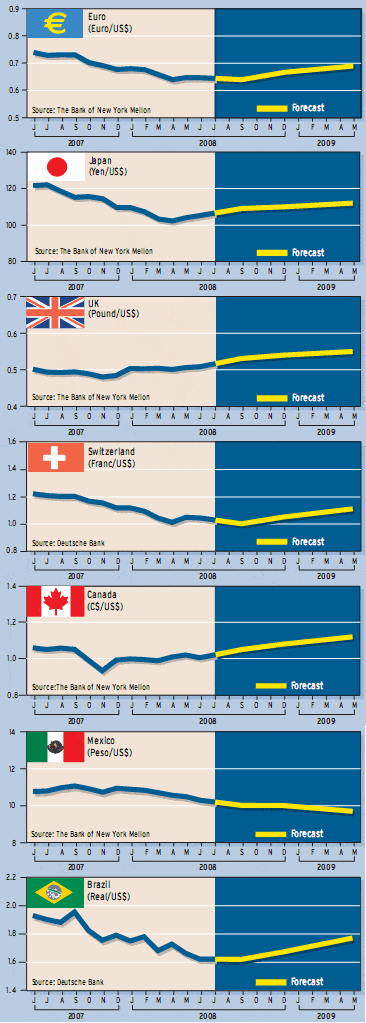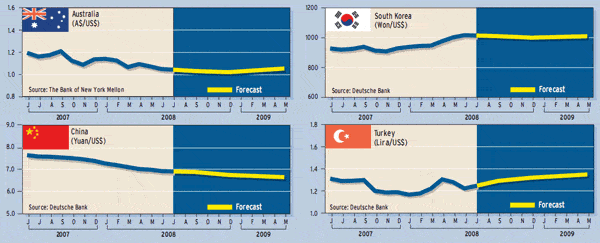FOREIGN EXCHANGE
Federal Reserve chairman Ben Bernanke gave the dollar a powerful boost last month with his observation that a weak dollar was contributing to imported inflation. Even before Bernanke gave his noteworthy speech at an international monetary conference in Barcelona, Spain, the dollar already was rising on signs the US economy was proving more resilient than expected and may have avoided recession.
It is quite unusual for a Fed chairman to comment on the value of the dollar, since it is the Treasury department that sets dollar policy and tells the Fed when to intervene in the foreign exchange market. “In collaboration with our colleagues at the Treasury, we continue to carefully monitor developments in the foreign exchange markets,” Bernanke said.
“We are attentive to the implications of changes in the value of the dollar for inflation and inflation expectations and will continue to formulate policy to guard against risks to both parts of our dual mandate, including the risk of an erosion in longer-term inflation expectations,” the Fed chief added. If the Fed is successful in achieving both price stability and a strong economy, the dollar will remain strong and stable, according to Bernanke.
CURRENCY FORECASTS

The continued and unwelcome rise in inflation and inflation expectations may force the United States and the other members of the Group of 7 major industrialized nations to begin raising interest rates again before year-end as the current financial market crisis abates, according to Woolfolk.
“Bernanke has signaled very clearly that we have seen the last of the Fed’s easings,” says Dennis Gartman, editor and publisher of The Gartman Letter, a Virginia-based investment advisory service. “He knows that he cannot come out with a clear statement to the effect that the Fed is done easing, for the stock market would take that very badly indeed,” he explains. “Thus, by commenting upon the dollar and the need for a stronger currency, he has couched ominous news on the interest rate front in positive terms,” he says.
The dollar strengthened a week earlier when Richard Fisher, president and CEO of the Federal Reserve Bank of Dallas, indicated that the Federal Open Market Committee’s propensity to tighten monetary policy was rising and that the FOMC’s propensity to ease further was low and falling.
Marc Chandler, global head of currency strategy at Brown Brothers Harriman, based in New York, says that rather than emphasize how a weak dollar boosts foreign demand for US goods, which helps blunt the impact of a pullback in US demand, Bernanke’s comments about the dollar were really about the inflationary impact of a weaker currency. “This also seems broadly consistent with the G-7 stance about the dollar and the risks that the volatility in the foreign exchange market could be contributing to the destabilizing appreciation of commodity prices,” he says.
“In his first speech on the economy in about two months, Bernanke largely did not tell the market anything it did not already know,” according to Chandler. “Risks to growth are on the downside, and risks to inflation are on the upside.”
The US economy is proving stronger than expected and has yet to record a three-month period of declining gross domestic product, although the housing market remains in dire shape, Chandler says.
Home prices are falling at a rate faster than the worst decline of the Great Depression, based on the latest data from Case-Shiller, and incomes after inflation are not rising, according to David Gilmore, partner and economist at Essex, Connecticut-based Foreign Exchange Analytics. “This is a consumer-based economy, and without a consumer set on spending and borrowing, no amount of export growth can offset a consumer heading for the hills when it comes to GDP,” he says.
With tighter lending standards, falling housing prices shutting off the home-equity ATM machines, and surging food and energy prices cutting into disposable income, the consumer has lots more adjusting to do, Gilmore says. “The US economy is the most challenged it has been in my memory,” he says. The idea that a revised increase of 0.9% in first-quarter GDP, instead of the earlier reported 0.6% rise, is confirmation of the economy averting a recession and being prepped for a significant acceleration is preposterous, he asserts.
Bernanke’s remarks on the dollar raised a red flag that currency intervention is on the table, Gilmore adds. “Why not jawbone the dollar higher as a first-line policy defense against inflation and leave rate hikes until later when the real economy and banking systems are out of the current batting slump?” he asks.
Bernanke said interest rates were well positioned for an economy facing both price pressures and threats to economic growth. If price pressures become the leading concern for the Fed, interest rates will go higher in the short term, and the dollar will follow, says Mark Frey, vice president of foreign exchange trading at Custom House, based in Victoria, British Columbia, Canada.
Bernanke sent a message to the market that, barring any monumental setbacks, the Fed has come to the conclusion of its interest rate easing cycle and has clearly moved to neutral ground with an eye to combating inflation as a top priority, Frey says.
Meanwhile, inflation and money supply growth in the eurozone are accelerating, raising the possibility that the European Central Bank will raise interest rates sometime this year. ECB president Jean-Claude Trichet told a press conference last month that the bank was on a heightened state of alertness because the risks to price stability had increased further.

Gordon Platt



